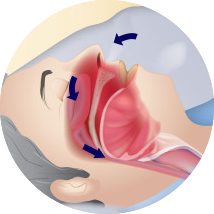Sleep Apnea Signs, Symptoms and Causes
One of the most common signs of sleep apnea is loud and chronic snoring. Throughout the night there might be pauses in the snoring, which may also result in choking or gasping. Snoring is typically the loudest when you sleep on your back—it might be less noisy when you sleep on your side. And, while you may not snore every night, the pauses in breathing might occur every night.
You are asleep when your snoring or gasping happens, which means you are unaware of this. You won’t be able to tell that you are having problems breathing unless a family member or bed partner notices the problems. It is also important to note that not everyone who snores has sleep apnea, just as not everyone who has sleep apnea snores. Other signs and symptoms of sleep apnea are:
- Excessive sleepiness during the day
- Falling asleep while driving
- Morning headaches
- Memory or learning problems
- Not being able to concentrate
- Waking up frequently to urinate
- Dry mouth or sore throat when you wake up
By understanding the signs and symptoms, as well as causes, you can better care for yourself or your bed partner.




